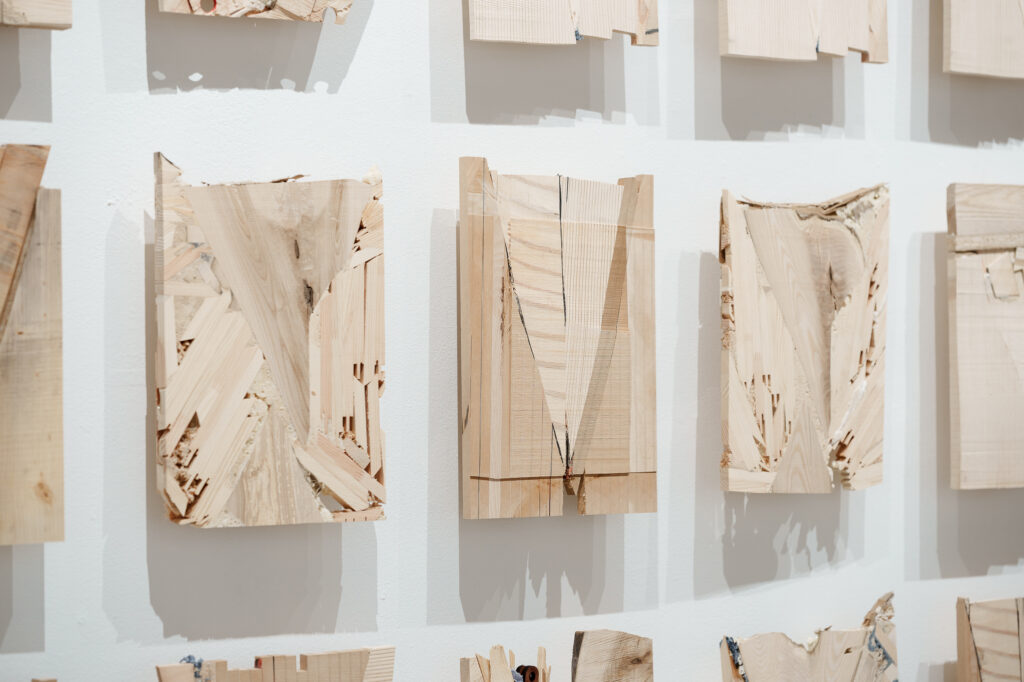
Mihkel Ilus (1987) is visual artist, who works in the expanded field of painting. Often, he makes large installations to which a painterly approach is central. An important part of his oeuvre is made up of an intertwining critical approach to contemporary exhibition culture and performance art. Lately, he has been focusing on the effect of object-based art in the settings of the black box and white cube.
One of his first painting-critical exhibitions was “Robusto” (2013), in which he exhibited constructive architectonic objects, from which expressive canvas surfaces were robustiously clinging on. Seldom aesthetic methods and similar treatment of canvas was continued in the series “First Method” (2014), in which Ilus experimented with ornamental and other decorative intentions on stripped frames.
His master thesis’ project “Outlet Workspace” (2015) progressed from the surface of the canvas by exhibiting a voluminous installation made of fluorescent lamps. The found-situationist work, derived from the former factory’s conditions and material memory, followed the same compositional notions as tension, rhythm, figure, surface, contour, which are used for describing a painting, allowing to understand “painting” and “painterly” much more freely.
The exhibition “Stick it to your wall” (2017) dealt with the components of painting, bringing out the dependence on the materials of the painting in its experience. Ilus brought forth the elements that emphasize the standardness of canvas by imitating, mocking and fetishizing the means of painting that are used not just in the artist’s studio but also workshops (such as tie down straps made of canvas with buckles made of plywood, table legs), reconfigurations of elements of painting (large wooden wedges, compositions with oil paint) as well as play with forms (wooden arches, pennants), from which none of them is conventional figurative painting. The exhibition “How else could I put it” (Hordaland Kunstsenter, Bergen, curator Siim Preiman, 2018) continued with the previous play with the components of painting, using monochrome visual language.
Mihkel Ilus has analysed the experience of exhibition in collaboration with Hanna Aasamets at “Vanishing Point” (2014) and Marten Esko at “Dead-End” (2016). The exhibition “Dead-End” was a gradually developing exposition, which was divided into six acts and eighteen chapters with a film epilogue. The viewers were expected to visit the gallery several times to get a taste of the constant change of objects, materials and the temporal nature of thought. The authors of the exhibition visualised the cluelessness, which arises when making selections and decisions, by using as means of expression the specifics of exhibition culture and metaphorical meanings of materials.
Among other things, Ilus has collaborated with performance artist Henri Hütt in different theatres and exhibition spaces in the project “Caprices” (1, 2, III, Pre-amp, 3,5; 2011–2018), in which the roles of audience, performer and technical support is constantly changing. The performative installation “Caprices” is a continuous project, which is a symbiosis of performance art and exhibition culture practices. Its authors play through the scenarios of deconstructing theatre and figurative art, bringing forth requisites that are used to create a common performing and exhibiting context.
Mihkel Ilus studied painting at Tartu University (BA, 2010) and the Estonian Academy of Arts (MA, 2015). He has participated in group exhibitions, co-curated young artists exhibitions in Tallinn Art Hall and elsewhere, and co-directed and participated in performance art projects. He was awarded the Eduard Wiiralt scholarship (2012).